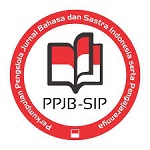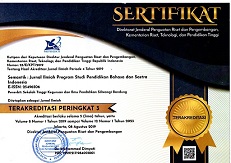BUNYI SERTAAN PADA PELAFALAN PENYANYI YURA YUNITA: PEMANFAATAN KAJIAN FONETIK SEBAGAI BAHAN AJAR MATA KULIAH FONOLOGI
DOI:
https://doi.org/10.22460/semantik.v9i2.p77-84Keywords:
LINGUISTIK INDONESIA, BAHAN AJARAbstract
One type of phonetic study is the accompanying sound. The sound of inclusion indaily life is often not recognized. This is becouse the accompanying sound is produced accidentally by the speaker. Assessment of speech sound can improve the ability of students to listen and identify one type of phonetic study, teh sound of inclusion. The research method used is a qualitative research method with descriptive analysis research type. The data in this study were divided into primary data in the from of songs sung by singer Yura Yunita and secondary data in the from of books, journals, and articles. Data analysis is done by collecting all the notes in the fiels, then reducing the data in the form of sound, after that present it into a pattern that is formed, to produce conclusions. Based on the results of an analysis of two songs entitled “Malam Sunyi†and “ Harus Bahagia†found thirtteen accompanying sounds. The thirteen accompanying sounds are included in teh types of sounds including labisation, palatalization, retroflexion, glottalization, aspiration, and nasalization. Thus, teh song spoken by Yura Yunita can be used as an alternative teaching materials for phonology courses, especially in the accompanying soun materials.References
Azizah, A. N. (2020). Lagu sebagai media pembelajaran fonologi pada siswa mi muhammadiyah trukan. Jurnal Bahasa dan Sastra, 8(1), 52–59. https://media.neliti.com/media/publications/318473-lagu-sebagai-media-pembelajaran-fonologi-53397b17.pdf
Chaer, A. (2013). Fonologi Bahasa Indonesia. Rineka Cipta.
Ifadah, M. (2012). Keefektifan Lagu sebagai Media Belajar dalam Pengajaran Pronounciation/Pengucapan. Seminar Hasil-Hasil Penelitian-LPPM UNIMUS, 363–370.
Moon, Y. J. (2020). Koartikulasi dalam bahasa manggarai: kajian fonologi generatif. PROLITERA: Jurnal Pendidikan Bahasa, Sastra, dan Budaya, 3(1). Retrieved from http://unikastpaulus.ac.id/jurnal/index.php/jpro/article/view/460/370
Muslich, M. (2015). Fonologi Bahasa Indonesia: Tinjauan Deskriptif Sistem Bunyi Bahasa Indonesia (F. Yustianti (ed.); Ketujuh). PT Bumi Aksara.
Pangesti, F. (2018). Perubahan bunyi bahasa jawa : kajian linguistik diakronis bahasa jawa kawi — JAWA BARU. Prosiding SENASBASA, 130–138. Retrieved from http://eprints.umm.ac.id/45250/21/Pangesti - Perubahan Bunyi Bahasa Jawa Kuno Bahasa Jawa Baru Linguistik.pdf
Rahayu, I. M. (2005). Variasi dialek bahasa jawa di wilayah kabupaten ngawi: kajian dialektologi. Skriptorium, 1(2), 27–34. Retrieved from http://www.journal.unair.ac.id/filerPDF/skriptorium75d2c56684full.pdf
Rosyida, D. I. (2018). Yura Yunita sebagai brand ambassador produk matoa. SpeSia UNISBA, 4(1), 199–207.
Sugiyono. (2012). Metode Penelitian Kuantitatif, Kualitatif dan R & D.Bandung:Alfabeta. Metode Penelitian Kuantitatif, Kualitatif dan R & D.Bandung:Alfabeta. https://doi.org/10.1017/CBO9781107415324.004
Yas, D. A. W. (2017). Bunyi Segmental Bahasa Manduro Di Desa Manduro Jombang Jawa Timur [UNIVERSITAS BRAWIJAYA]. Retrieved from http://repository.ub.ac.id/8208/1/DIAN AYU WAHYUNING YAS.pdf
Yuliana, R. (2017). Pembelajaran membaca permulaan dalam tinjauan teori artikulasi penyerta. Prosiding Seminar Nasional Pendidikan FKIP UNTIRTA, 346.
Zahid, I.H. & Omar, M. S. (2012). Fonetik dan Fonologi. Retrieved from https://books.google.co.id/books?id=v3_MAgAAQBAJ&printsec=frontcover&dq=inauthor:%22Indirawati+Haji+Zahid%22&hl=id&sa=X&ved=2ahUKEwiQhYjHq4HrAhWzW3wKHQ24AfIQuwUwAHoECAAQCQ#v=onepage&q&f=false











